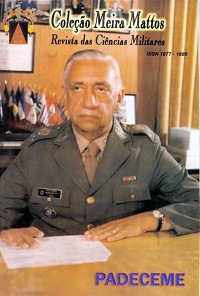The mobilization planning in the Brazilian Army to meet the employment hypothesis, its conditions and the integration with the logistics system.
Main Article Content
Abstract
After understanding the military con-ceptions of the expressions “Mobiliza-tion” and “Logistics” as well as their his-torical evolution, it becomes evident the impossibility of planning Logistics with-out considering the complementary Mo-bilization. In the same way, Mobilization only makes sense if aligned with Logistics that, in its turn, will offer feasibility to the planned maneuver. The maneuver has the Hypotheses of Employment (HE) as its base, their variants and conditions, and is expressed by the Campaign Plans of the Military Commands Region, which contemplate various scenarious. The pro-posal of this study is to conceive a mo-bilization planning method to supply, the needs of the HEs, their conditionals and the integration with the Logistics System. It is important to the planner to know how and when to implement new Military Organizations, how to mobilize industries, health facilities and storage sheds deposits of supplies and how to ob-tain and to distribute material and human resources (chapters 5 to 9), gathering the logistics functions “Human Resources”, “Supply” and “Transport.” The plan-ner is also supposed to consider the as-pects inherent to the logistics functions: “Maintenance”, “Health”, “Engineer-ing” and “Rescue” (chapter 10). Finally, a mobilization planning method (chapter 11) is presented in this research. This method, for a better integration with the Logistics System, is based on each one of the logistics function. The Mobilization proceeds, then, beyond the evolution of the “Military Structure of Peace” to a “Military Structure of Defense”: provid-ing the support continuity. The planning begins at the Ministry of Defense, that defines the HEs, that have to beconsidered by the Terrestrial Operations Com-mand (COTER) while drawing up its Draft Plan of Management (DPOM) to the Military Commands. The maneuvers created by these commands and shown in their campaign plans, define the limits of possible Theaters of Operations, avail-able forces, the troop concentrations, etc forming “scenarious.” These scenarious guide logistics plans that guide the mo-bilization plans. Therefore, the logistics organization in peace time, the military region (RM), whether evolving into act-ing in theaters of operations (TO) or in-ner zone (ZI) will plan the mobilization through the analysis of the logistics func-tions in each scenario. Following this method, the Mobilization planners of the military regions will create and mantain an update database from companies, in-dustries, reservists, facilities, specialized personnel, etc, as described in this study, in order to mobilize personnel, facilities, of equipments and supplies without wast-ing of time or of financial resources.
Downloads
Article Details

This work is licensed under a Creative Commons Attribution-NonCommercial-ShareAlike 4.0 International License.
Meira Mattos Collection is licensed
From 2019 under Creative Commons conditions (CC BY 4.0)
Until 2018 under Creative Commons conditions (CC BY-NC-SA 4.0)
Licenses are listed on the article access page and detailed on the Copyright page of this publication.
Copyright: The authors are the copyright holders, without restrictions, of their articles.
Notice
For any reuse or distribution, you must make clear to third parties the terms of the license to which this work is submitted.

